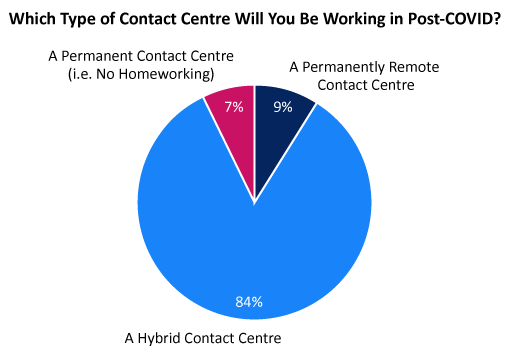Our panel of experts share their predictions for how the contact centre industry will change and develop in 2021.
1. COVID-19 Will Continue to Change Everything
Contact centres employing hundreds of agents have a high risk of exposure to coronavirus, which is why most will not resume normal operations.
However, the switch to remote working has opened the eyes of many as to the benefits – in terms of flexibility, well-being and productivity – of homeworking, with most contact centre planning a future with a hybrid contact centre model.

This poll is made up of data sourced in the Call centre Helper Webinar: Contact Centre of the Future
These statistics indicate that contact centres are unlikely to return to the conventional ways of doing things, but that they will also not be fully remote. Most will look for the optimum balance of the two.
2. Your Data Won’t Be as Secure as Before
In 2019, there were 1,506 data breaches in the United States alone, each costing an average of $3.9 million. In fact, 22% of all breaching cases revolve around phishing.
Security incidents took place before the pandemic, and work-from-home arrangements have increased such vulnerabilities.
Ransomware attacks have grown in prevalence as well. What’s concerning is that these security incidents took place before the pandemic, and work-from-home arrangements have increased such vulnerabilities.
If your contact centre isn’t training remote agents about the latest hacking and phishing tactics, it’s only inviting disaster.
Furthermore, system administrators need to stay on top of all manner of apps, restrict remote agents from installing unauthorized software, and update to the latest security measures.
3. Reliance on Social Media Will Increase
If social media is everywhere, then a brand has to be everywhere for its followers. By this logic, contact centres’ reliance on social media will increase in 2021.

Yasir Bugrara
Whether your facility employs chatbots or human agents to interact with consumers, your social media use should demonstrate responsiveness and care in resolving issues, as well as make two-way conversations public to show other customers how problems were solved.
Such interactions add up to an improved customer experience and greater credibility, both of which are gold.
Contact centres not ready to employ biometric methods may also make greater use of social media authentication as a stopgap measure to confirm customers’ identities.
Thanks to Yasir Bugrara at Voci Technologies
4. Contact Centres Overcome Remote Working Challenges
As homeworking looks to increasingly become a part of contact centre life, there are key considerations that contact centres need to consider and overcome for their remote working strategy to stay successful. These include:
- Employees who were not initially hired on a work-from-home contract may begin looking to have their employer contribute towards the costs and disturbance to their wider homeworking environment, from desks and chairs to connectivity, heat and light.
- A distributed workforce leads to new security risks, and not just in terms of enterprise grade secure connectivity. The homeworking environment isn’t necessarily secure in the physical sense, for example, and IT displays can be viewed or photographed, giving rise to potential GDPR breaches.
- Contact centre agents are used to working near colleagues providing support and camaraderie. Some employees may experience loneliness, depression or a lack of confidence when deprived of this close-knit atmosphere, and management will need to ensure they’re providing sufficient support.
5. The World of Hybrid Work Is Fast-Approaching
A key implication of increased homeworking is that staff will split time between home and office.
Contact centre managers will need to provide a flexible workplace that permits employees access to applications and services, and enables collaboration wherever teams are based.

Derek Lewis
With this in mind, they need to keep the following considerations in mind:
- Cloud technology supports hybrid working and in enabling agents to work from multiple semi-permanent locations. Cloud solutions are agile and maintain business continuity.
- For those that will be office-based, tools must be provided to remain COVID-secure. From fixed desks, to personal comms kits, collaboration tools, and scheduling systems, the contact centre of 2021 will require a range of key solutions and practices.
- Ensure staff’s homeworking environments are compatible with voice calls, consider broadband management solutions to protect call quality, and promote adherence to tested and approved equipment, e.g. headsets.
Thanks to Derek Lewis at Maintel
6. The Rise of the Customer-First Contact Centre
It’s not just enough to be customer-centric, organizations now must be customer-centric in a remote-working environment. Customers were understanding to begin with, but as the “new normal” transitions to “normal”, their patience with businesses may wear thin.
In 2021 we can expect to see businesses, if they haven’t already, transition to a contact centre model that helps put customers first.
We’ll start to see businesses evolve and remodel their call centre operation to ensure their remote digital experience works in line with customer expectations.
While some are turning to technology such as chatbots to deflect high call volumes and support customer queries, if these are not integrated with the correct wider processes in places, this could see a rise in customer frustration towards technology-operated services.
More broadly, we’ll start to see businesses evolve and remodel their call centre operation to ensure their remote digital experience works in line with customer expectations. This will not only hold them in good stead to exceed these expectations, but also improve their competitiveness in the market.
7. Talent Will Prevail Over Location
As contact centres have shifted to enable employees to operate from anywhere, so has the talent pool available to them. The companies that are best able to leverage remote onboarding and hiring will be highly competitive going forwards.

Chris Marron
Now that companies can focus on talent, it will enable more high-powered employees that are empowered to work independently, perhaps even seeing an increased focus amongst contact centre employees on targets and commission.
It’s a great opportunity for businesses to create a more diverse talent pool. Single-parent families, disabled workers, and others who may not have been able to commit to a daily commute can now offer their skills to businesses, who should be jumping at the opportunity to increase diversity.
Thanks to Chris Marron at 8×8
8. Customer Demand for Complex Support Increases
In a recent Calabrio survey, one of the key findings was that the pandemic has caused heightened customer expectations, with three in four respondents believing that this will remain long after the acute crisis subsides.
This change, combined with increased demand as customers are unable to visit stores or obtain help from their usual sources, could lead to customer experience headaches, at a time when people need more help with complex problems.

Contact centres will need to strike a balance between live agents and automated self-care.
Customers will continue to flood contact centres with calls as they encounter technical issues at home.
Generally, human agents have been accepted as a superior solution to self-service options during the pandemic. This means that contact centres will need to strike a balance between live agents and automated self-care. A tricky balance for 2021.
9. Customer Journey Maps Will Need Tweaking
The pandemic has caused processes to change. This impacts customer experience, and your customer journey maps may need readjusting to control that change.
Also, surges in e-commerce and speedy adoption of digital services means customer behaviour has changed and it is likely to fluctuate for the medium to long term, making it more important than ever for companies to continually rethink how they engage with customers.

Magnus Geverts
Many retailers warn customers who are shopping online that high demand has pushed delivery times out and therefore encourage the use of their shops which are safe and ready to welcome customers in person.
Delays in delivery and increased use of e-commerce will inevitably cause more queries and demand into contact centres. This is another reason why you may need to tweak your customer journey maps, which you should then use as a communication tool across the business.
Thanks to Magnus Geverts at Calabrio
To download Calabrio’s new survey – as highlighted at the start of point eight – follow the link: The State of the Contact Centre: Embracing the Evolving World of Work
10. Mental Health Moves up the Priority List
Issues of mental health and well-being are likely to move further up the priority list for contact centre managers during 2021.
These unique times have brought unique pressures with customers placing more demands on the contact centre.
With staff working from home, it is much harder for managers to see how agents are coping. These unique times have brought unique pressures with customers placing more demands on the contact centre.
It is hard to see if an agent is becoming stressed and emotional, and therefore much more difficult for managers to be there for agents and support them.
As a result, we will see an evolution in technology that businesses use to support their agents in their work, as well as new processes and procedures put in place to help.
Real-time speech analytics could be used, for example, to measure the stress and emotion that agents are showing.
Regular video calls could be put in place to get teams together for virtual social events, where they have a chance to build strong connections and get a clearer sense of working together positively as a team.
11. Video, Video and More Video
2021 is likely to see a continuation of the theme of this year, with video being much more widely used in the contact centre.
We foresee multiple applications for video, including staff training and remote team meetings, as well as for health and well-being purposes, and of course for customer engagement.
We foresee multiple applications for video, including staff training and remote team meetings, as well as for health and well-being purposes and of course for customer engagement.
In the latter case, that could include everything from a retailer demonstrating the benefits of a particular product to a field engineer explaining how to fix a broken tap, or a doctor holding a patient consultation.
Explanatory videos could also be posted on the company website or social media platforms, helping to reduce incoming calls to technical specialists within the business by providing video answers online that help customers solve common problems for themselves.
12. Cloud Migration Will Continue to Soar
We will see a continuation of the shift towards cloud-based platforms and infrastructures during 2021.
The contact centre has already virtualized and it will continue to move in that direction over the course of the next year.
Many businesses have now accepted that staff working from their studies, bedrooms or dining room tables is the new normal, at least in the short term.
Google has said its employees will work from home at least until the summer of 2021, and Microsoft are allowing more of its staff to work from home permanently.

Jeremy Payne
It can be predicted that many organizations, including contact centres, will move to more of a hybrid working model in which staff will be encouraged to work remotely as well as having the opportunity to use the office as a collaboration and meeting space.
In a contact centre context, that approach is enabled by cloud but also by the concept of the connected enterprise, where experts and specialists in IT, negotiation and social media, to name just three examples, can be folded into the conversation when required.
Thanks to Jeremy Payne at Enghouse Interactive
13. Other Departments Begin to See Value in the Contact Centre
While contact centres were seen as “cost centres” by many, the COVID-19 outbreak has emphasized their value to the rest of the business.
The contact centre is a powerful resource for finding out what customers think of companies, their most important desires/concerns and capturing sentiments.
To gain better insights, let’s hope that contact centres are given extra budget to obtain better insights, including:

Vincent Van Den Bossche
- Analytics
- Cloud solutions
- Co-browsing
- Live engagement
- Omnichannel communication
- Recall technology, also called “on second thoughts technology – OST”
- Social media engagement
- Workforce engagement tools
Recall technology is a particularly interesting example here, as it also helps the contact centre to maintain accuracy in every conversation. This technology upholds conversation flow without negatively impacting customer satisfaction.
Thanks to Vincent Van Den Bossche at Wisper
14. Analytics Systems Will Help to Assist Agents
In order to make sure that agents feel like they’re getting the support they need, and in turn, are able to deliver the best customer experience possible, organizations are going to have to track engagement.
Organizations are going to be able to measure every aspect of customer interaction more effectively in real time…
Through speech analytics, organizations are going to be able to measure every aspect of customer interaction more effectively in real time, such as emotion, silence and compliance.
By measuring how well agents perform across every customer interaction – not just a small proportion of interactions – as well as delivering real-time guidance and coaching, we can measure key signs of engagement. We can then look to support them, while also helping them to improve performance.
Remember, when employees are happy, customers are happy.
15. Customer Vulnerability Becomes a Key Consideration
In 2020, the notion of “vulnerability” gained significant attention. Customers were facing unemployment, financial difficulty, illness and more, thanks to the pandemic.
Yet, while COVID-19 certainly exacerbated vulnerability, the idea of the “vulnerable customers” isn’t new.

Frank Sherlock
Organizations interact with vulnerable customers every day – but due to the pandemic, vulnerability (and how organizations deal with vulnerability) will become even more important in 2021.
In 2021, we’ll see more organizations setting strategies and processes for understanding vulnerability, identifying at-risk customers and equipping agents to properly manage these relationships, including real-time alerting and next-best-action guidance.
Thanks to Frank Sherlock at CallMiner
16. Gamification Strategies Gain Momentum
Entering the second year of a global pandemic, many contact centre agents have become comfortable with newfound remote work conditions, and fears of a productivity drop have, in most cases, proven to be unfounded.
However, maintaining agent engagement and a positive work environment remains crucial to delivering rewarding customer service, which is why implementing gamification into agents’ work will be leveraged with greater urgency.
Maintaining agent engagement and a positive work environment remains crucial to delivering rewarding customer service…
With 80% of agents working alone, it is more important than ever to build team unity and motivate agents beyond financial gain.
Incentivizing work through virtual game mechanics (points, badges, leaderboards) is a great way to boost morale.
With contact centres combating demotivated and detached agents, 2021 may very well see a surge in gamification.
17. Customer–Agent Video Conversations Become More Commonplace
Enabling video channels is not just about agent and customer being visually engaged. Rather, it is mostly about providing a mechanism that allows agents to see what customers see, guide them through processes and shorten resolution time, for the benefit of both parties.
Video capabilities enable agents to pause images, zoom in and send additional information.

Neil Titcomb
Moreover, video facilitates collaborative conferencing, making it easy for agents to receive support from colleagues and supervisors.
As customer visits to brick-and-mortar locations continue to decrease, the role of video in customer service will become vital to customer journeys.
Thanks to Neil Titcomb at Odigo
18. Digital Offerings Will Determine Success
Last year, I predicted that Gen Z and Millennials would drive a spike in the further adoption of a wide range of digital channels in the contact centre.
Their digital fluency would, in theory, drive contact centres to embrace a digital-first policy to meet customers where they are.
Technically, this prediction did come true, but not for the reasons we anticipated.

Digital channels became a significant value driver as contact centres increasingly engaged with customers at home.
When the world went on lockdown, digital channels became a significant value driver as contact centres increasingly engaged with customers at home.
While we cannot say with confidence when the pandemic will end, it’s important to note that the skills and preferences customers have developed during this time will be lasting – especially as they emphasize convenience.
Regardless of timeline, the value of digital in the contact centre is here to stay.
19. AI Shows Even More Promise
AI has been on the contact centre wish list for years. As it has developed, some contact centres have seen value in driving more personalized conversations and improving IVR menus.
That said, core business functions and continuity usurped the importance of next-gen solutions as the pandemic hit in full force.
Rather than experimenting with potential use cases, it was all hands on deck for contact centres as they transitioned staff home for the first time, without missing a beat in terms of delivering service.
The change in priority was a smart, if necessary, choice on behalf of contact centre leadership. In fact, in cases where contact centres were already operating on cloud software, this emphasis ensured a seamless transition to remote, with contact centres fully up and running remotely in as soon as 48 hours.

Chris Bauserman
Additional investment was also put into giving agents the tools they needed to replicate the experience at home, from training and feedback to operational processes like time off.
With the bulk of disruption behind contact centre leaders, in the short term, AI acceleration is once again beginning to heat up and that will hopefully continue into 2021 and beyond.
Thanks to Chris Bauserman at NICE inContact
20. Proactive Customer Service Will Take Another Step Forwards
Businesses that focus on minimizing customer churn and improving customer loyalty often focus on the contact centre, especially by improving inbound customer experiences.
However, few companies have developed outbound engagement strategies that drive customer loyalty, and these types of initiatives are excellent opportunities for organizations to differentiate themselves from the competition.

Michael Kropidlowski
One of the best ways that organizations can improve their customer experiences is to develop personalized proactive outreach strategies that deliver relevant and timely information at the right time and help customers solve problems before they arise.
Driving effective outbound campaigns requires best-of-breed proactive engagement software, which helps organizations efficiently contact their customers while maintaining compliance with key regulations.
Thanks to Michael Kropidlowski at Aspect Software
21. Quality Assurance (QA) Will Become Increasingly Automated
While contact centres are exceptionally good at measuring quality and service metrics for phone interactions, they struggle to achieve the same visibility and service quality on digital channels.

Shorit Ghosh
In 2021, contact centres will need to invest in tools that provide an end-to-end view of the customer journey, identifying friction points, quality of service and team performance issues.
Many manual QA approaches have been made more tricky with rise in remote working, and contact centres will need to automate discovery of “coachable moments”.
Thanks to Shorit Ghosh at Clarabridge
22. Voice Will Drive Customer Experience
Many organizations have lost their ability to deliver in-person service to their customers. As a result, call centres are now acting as the primary conduit for brands to communicate with customers.
Voice enables brands to make human-first connections with customers, replacing what would have been face-to-face interactions with meaningful, high-value calls. This is especially important in complex situations that require a friendly voice and empathetic ear.

Richard Kenny
Sound quality, where both agents and customers can hear and be heard, is key to creating the best call experiences, and the choice of headset can be critical in driving satisfaction.
Headsets like the Poly Encore Pro have noise-cancelling capabilities built in, which means unwanted background noise can be blocked from the customer and agents can focus completely on the interaction.
In 2021, it will be key for brands to put voice at the heart of their customer experiences, to deliver better service, gain loyalty and keep valuable customers.
Thanks to Richard Kenny at Poly
23. Digital Takes Over… Finally
Reaching companies via phone can be difficult, and problems like long wait times due to lack of staffing aren’t uncommon.

Craig Farley
As a result, many customers are turning to non-phone methods of communication, and companies themselves have found this easier to service.
This leads to a perfect storm: increasingly capable and easy-to-use cloud contact centre services with built-in omnichannel, companies looking to switch IT strategy to cloud, and customers wanting consistent service across multiple channels.
So, 2021 will be the year that omnichannel truly takes off in the form of the cloud contact centre.
Thanks to Craig Farley at IP Integration
24. Focus on Employee Well-Being Will Increase
Even before the COVID-19 pandemic took over our lives, we had started to see a positive focus on employee engagement. The pandemic has not only put our health under the spotlight, it’s also given us time and space to reflect on what is important in our lives.

Alex Stenton-Hibbert
2021 will see more employees demanding work–life balance and the ability to prioritize family and their well-being (mental and physical) when necessary. According to a recent study conducted by Contact Babel, anxiety and mental health issues have emerged as a major contact centre issue during the pandemic.
Tools like shift trading and self-scheduling will help solve work–life balance issues and will offer a much-needed solution for organizations, allowing employees to swap shifts with colleagues when needed whilst maintaining business service level agreements and engagement at the same time due to increased flexibility.
Thanks to Alex Stenton-Hibbert at Business Systems
25. AI Will Strengthen Security Systems
AI-based security, biometrics, and fraud detection will be more important than ever as incidences of cybercrime increase, a result of greater online activity fuelled largely by the global pandemic.
With the onset of the pandemic, more consumers are conducting business online and, as a result, we are seeing a significant increase in fraudulent activity and cybercrime.

Joe Petro
AI solutions that provide advanced security, biometrics, and fraud detection to protect consumers and brands will be even more important, and we will see an increase in companies adopting and implementing these technologies, as well as consumers expecting and demanding them.
Brands that leverage passive authentication technology, like biometrics, to provide an effortless but secure customer experience will be ahead of the curve in providing customer care that protects those who interact with their brands.
Thanks to Joe Petro at Nuance
26. Customer Experience and Channel Strategy Align
It’s important to understand how and where your clients are contacting you. Are they coming through search engines? Your website? Picking up the phone?

Tim Kimber
Identify a couple of key channels and invest in them to ensure customers and prospects can communicate with you in the way that they want.
Virtual assistants and AI usage is on the rise and there have been big improvements in this technology, meaning that basic queries can be easily resolved.
It is also good practice to ensure that all conversations that take place are centralized and easily accessible by agents as required.
Thanks to Tim Kimber at Vonage
27. Metrics and Dashboards Come to the Fore
The call centre is a hub of interactions between businesses and customers, and every conversation churns out new valuable data.
Collecting information on everything from average handling time (AHT) to first call resolution (FCR) will be essential in any contact centre.

Sam O’Brien
More environments are using state-of-the-art analytical tools to turn metrics into meaningful actions for the entire team.
Workforce management tools and cloud services can even turn metrics into dashboards and wallboards that help employees to track performance.
Crucially, business leaders will need to measure not just the outcomes of interactions between employees and customers, but the success of internal collaboration too. Teams that work better together on the back end, perform better when customer-facing.
Thanks to Sam O’Brien at RingCentral
28. Providing Visibility Into Agent Performance Becomes Key
A direct result of a workforce that is no longer in one physical location at all times is the need for greater visibility across the remote contact centre.

Aviad Abiri
Contact centres must be empowered with real-time digital insights driven by advanced analytics and AI.
These insights can provide better information into what advisors are doing and better guidance on areas for improvement, but at the same time can be used to drive real-time action during live customer interactions.
Real-time digital insights can be implemented to help businesses use analytics to inform the actions they should take immediately and in the moment, personalizing interactions, increasing efficiency and creating great customer experiences.
Thanks to Aviad Abiri at NICE
29. There Will Be Less Need for Office Space
Over the following year, we can expect to see business leaders continue to build upon hybrid working strategies.
This will see virtual collaboration technology, professional audio-visual tools and socially distant room configurations take centre stage as a way of improving virtual presence – as essential for customer experience as it is for reducing worker fatigue and complying with regulation.

Nigel Dunn
Across the industry, we will see decreased reliance on the office space. While this opens up opportunity for rental savings, contact centre employers will need to accommodate for the agents they employ in other ways.
The right combination of hardware and software can help agents do their job effectively while providing managers with the oversight and tools they need to lead.
Getting this right will unlock immeasurable ROI through productivity and customer satisfaction.
Thanks to Nigel Dunn at Jabra
30. Knowledge Bases Will Be Used to Assist Agents
Faced with an ever-increasing workload due to a worldwide surge in ecommerce activities, agents in the contact centre are in urgent need of greater autonomy and speed in answering incoming queries.

Sam Boyle
The ability to quickly tap a colleague on the shoulder and ask for help is gone, thanks to enforced work-from-home orders, and the days of housing one’s knowledge base in a difficult-to-access Sharepoint file or, in some cases, even a Word document, are over.
Agents need quick, reliable access to standardized answers in the form of dynamic, contextual knowledge bases and virtual agents.
Thanks to Sam Boyle at Inbenta
For more insights from our panel of experts, read our articles:
- 20 Contact Centre Objectives
- 22 Contact Centre Cost-Saving Ideas
- 18 Ways to Improve the Effectiveness of Your Digital Customer Service
Author: Robyn Coppell
Published On: 25th Nov 2020 - Last modified: 13th Jan 2025
Read more about - Customer Service Strategy, 8x8, Alex Stenton-Hibbert, Alvaria, Aviad Abiri, Business Systems, Calabrio, CallMiner, Chris Bauserman, Clarabridge, Craig Farley, Editor's Picks, Enghouse Interactive, Inbenta, IP Integration, Jabra, Jeremy Payne, Magnus Geverts, Maintel, Neil Titcomb, NICE, NICE CXone, Nigel Dunn, Nuance, Odigo, Poly, RingCentral, Tim Kimber, Voci Technologies, Vonage, Wisper, Yasir Bugrara








































